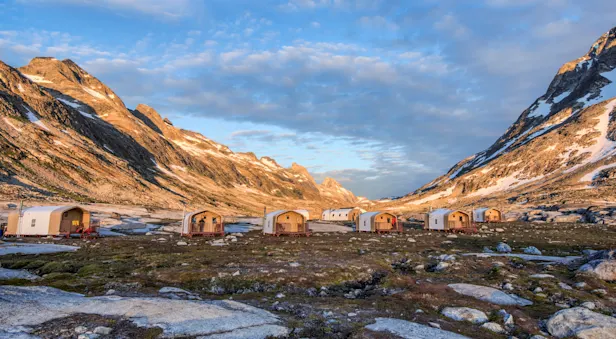Know Before You Go
Black Guillemot Facts | Greenland Wildlife Guide
Physical Characteristics
Black guillemots are small seabirds, only about twelve inches in length. Their legs and the inside of their mouths are a vivid red. There are seven known subspecies of varying plumage, wing and bill length, and size. Black guillemots’ plumage becomes entirely black during the mating season in summer, with the exception of stark white patches on their wings, which are retained through varying changes in plumage. They molt in early autumn, their feathers turning a speckled “salt and pepper” color, and their legs changing to a pale red.
During winter, the head and underside of the body turn white, while the back becomes a dabbled black and white. The plumage of juveniles appears similar to an adults’ winter plumage, with the addition of black markings on their white wing patches and a more mottled head.
Habitat
The black guillemot typically inhabits rocky shores, making its nest in cliff crevices, and occasionally under stones or driftwood. In the high Arctic, some cliff sites may be as high as 755 feet. They may also take cover in areas previously unsuitable for nesting, like under man-made infrastructures or in the crevices of harbor walls.
Behavior
Black guillemots display an array of social behaviors towards one another. They will aggressively guard their nesting site, perching on stones and giving a shrill whistle. They will also lunge at an intruder with open bills, chase them, and assume a defensive walking stance with their backs hunched and wings slightly open. Another behavior is the “leapfrog” chase, where a bird will fly over the other and land on the water in front of them. These “water games” begin courtship, which involves whistles, head bowing, and pairs swimming in circles.
Reproduction
Breeding occurs in small, dispersed colonies from late winter to early May. During copulation, the male will sometimes stand on the female’s back, stepping down with alternating feet. After mating, the birds begin looking for appropriate nesting sites. The mother lays her eggs between late May and mid-June. Black guillemots possess a double brood patch to incubate their eggs, which are typically two in number. The actual number of hatched chicks is much less, due to predators, storms, and flooding.
More seasoned mothers will lay their eggs slightly earlier and have a larger average clutch size. Parents share incubation shifts continuously for 28 to 32 days. Chicks take three to four days to completely hatch and are covered in black, soft down. Following incubation, the hatchlings are semi-precocial and are able to be left alone in their nest. Both parents feed their eager young with up to 20 fish per day. At 30 to 40 days old, the chicks becoming fledglings. Fledged young are self-sufficient, though parents may need to coax them out of the nest with fish. At 3 to 4 years old, black guillemots join the breeding cycle and begin to mate.
Black guillemots are monogamous, with breeding colonies ranging from ten to several thousand in number. Black guillemots in the southern regions of their range are less social, living in smaller colonies, as opposed to their more sociable, high Arctic counterparts. Black guillemots return to the same colony, and frequently the same nesting site, year after year. Occasionally, nesting sites will overlap with other auks, in fact, guillemot and razorbill eggs were once found in the same nest.
Feeding Habits
Black guillemots forage in shallow, coastal waters during the breeding season. Though they remain close to shore throughout the year, in the winter they wander the open ocean foraging along the edges of pack ice and farther offshore.
Black guillemots have wings that propel them through the water, enabling them to dive for fish, like Arctic cod, prickleback, butterfish, and sand lance. They also feed on invertebrates, such as jellyfish, crustaceans, crabs, mollusks, sponges, marine worms and barnacles. They are able to dive up to 164 feet for close to two minutes. The birds forage mostly during morning and evening hours, but in some regions, feeding occurs throughout the day.
See Black Guillemots on These Trips

Iceland: Circling the Land of Fire & Ice
An immersive journey into the rugged grandeur of a land sculpted by intense geological forces. Make a full loop around Iceland on the most comprehensive nature adventure this compact country has to offer.

























